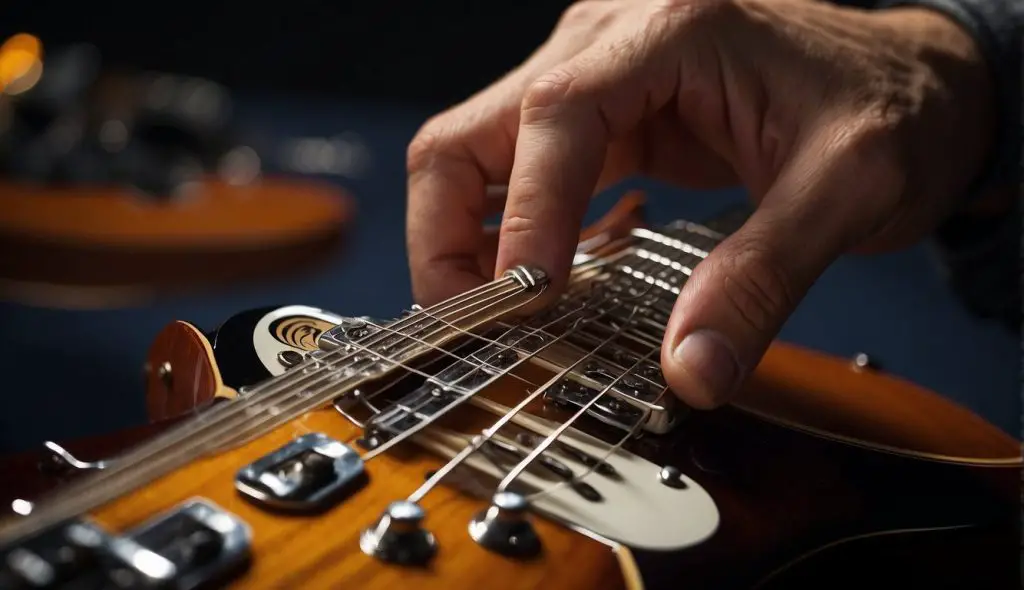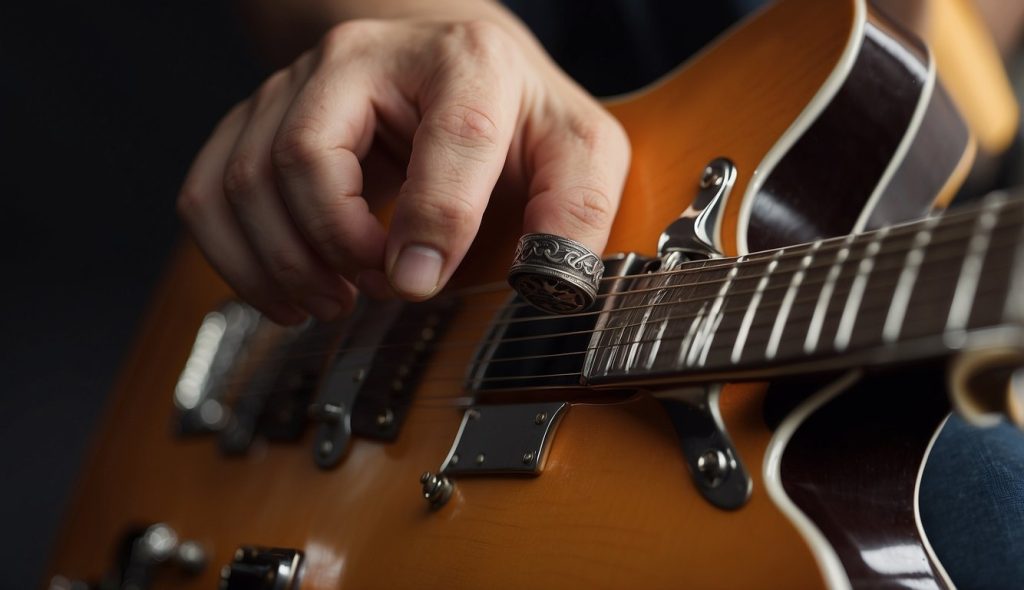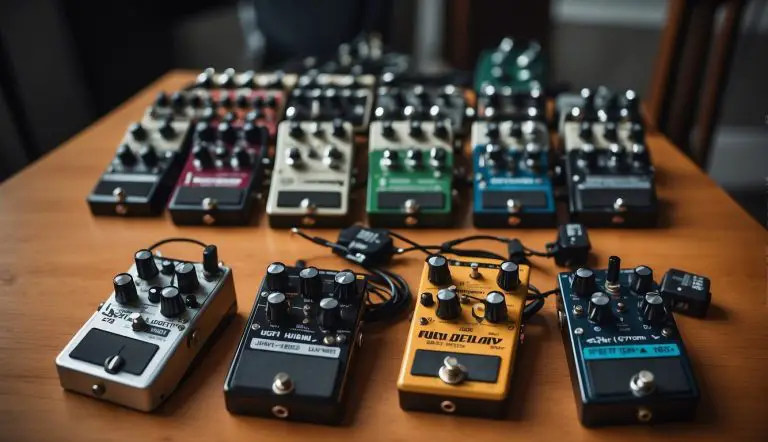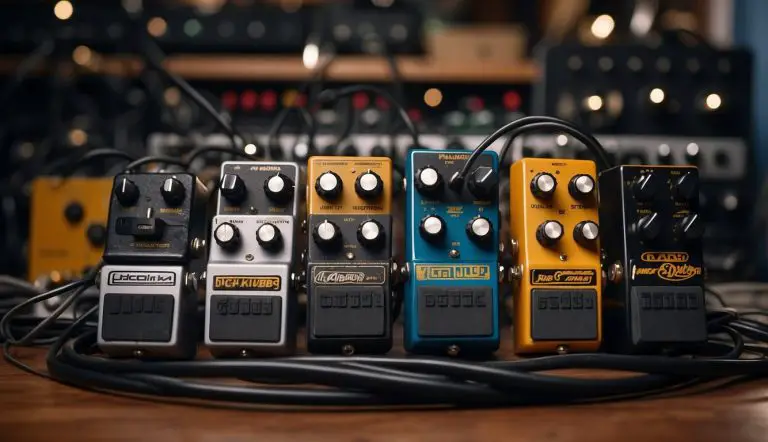How to Use a Thumb Pick: Mastering Guitar Picking Techniques
Using a thumb pick can significantly enhance the quality of sound when playing a guitar.
Unlike standard flat picks, thumb picks offer a more stable grip and enable the player to deliver a firmer and more consistent attack on the strings.
This technique often results in a brighter and louder tone, making it a favored choice for fingerstyle guitarists.
I have found that the ability to alternate between strumming and individual string picking without changing picks offers a versatile dynamic in my guitar play.

Selecting the right thumb pick is essential as comfort and fit are paramount for control and ease of use.
While learning to effectively use a thumb pick, mastering the proper technique is vital. It requires patience and practice but leads to a seamless integration of the thumb pick into various playing styles.
Through exercises and consistent practice, I’ve observed improvement in my precision and the ability to effortlessly incorporate a thumb pick into different music genres.
Key Points
- Thumb picks enhance guitar sound and allow versatile playing techniques.
- Correct thumb pick size and fit are crucial for comfort and control.
- Regular practice with a thumb pick improves precision and versatility in playing.
Table of Contents
Choosing the Right Thumb Pick
When I select a thumb pick, my focus is on the size, material thickness, and the fit to ensure that I achieve the best tone and comfort for playing.
How to Know What Size Thumb Pick to Use
The size of the thumb pick is crucial because it needs to stay securely on my thumb without causing discomfort. Here’s what I consider:
- Small, Medium, Large: I start by trying on different sizes to see which one fits snugly around the pad of my thumb without slipping off.
- Scale Models: Some musicians prefer to use scale models of thumb picks for precision sizing if standard sizes don’t fit perfectly.
Selecting Thickness for Tone and Attack
The thickness of the thumb pick affects the tone and attack of the strings. Here’s how I make my decision:
- Thin Picks: Usually produce a softer, warmer tone suitable for light strumming or fingerstyle playing.
- Thick Picks: Yield a sharper, more pronounced attack which is preferred in genres that demand a strong presence, like bluegrass or rock.
Ensuring a Comfortable Fit
Comfort is key for long playing sessions, so I take these factors into account:
- Material: Thumb picks are commonly made of plastic or metal. I choose plastic for a lighter feel or metal for added weight and volume, depending on the style of music I’m playing.
- Adjustment: Some thumb picks can be adjusted for a better fit by carefully heating and bending the material.
- Personal Preference: Ultimately, the best fit is subjective and driven by my personal preference.
In my experience, the perfect thumb pick is one that feels like an extension of my thumb, allowing me to play effortlessly for hours.
Fundamentals of Using a Thumb Pick
When I transitioned to fingerstyle guitar, mastering the use of a thumb pick was crucial for achieving the right tone and control. A thumb pick provides a distinctive attack that differs from traditional flat picks, essential in styles influenced by greats like Chet Atkins and Merle Travis.
Thumb Pick vs Traditional Guitar Pick
The Thumb Pick and a Traditional Guitar Pick serve similar purposes but have unique characteristics making them suitable for different techniques. Here are some of their differences:
- Shape: A thumb pick wraps around the thumb, combining a plectrum with a band, which allows for a different approach to strumming and plucking.
- Tone: The material and shape of a thumb pick often produce a brighter, more pronounced attack, complementing fingerstyle guitar’s nuances.
- Attack: With a thumb pick, the angle of attack is influenced by the rotation of the wrist, unlike a traditional pick that relies more on arm and finger movement.
Utilizing a thumb pick properly heightens the precision and articulation in my fingerpicking, resonating the signature sounds of artists such as Chet Atkins and Merle Travis.
Proper Placement and Angle on Thumb
Placement: To ensure my thumb pick stays securely without cutting off circulation, I position it roughly halfway down from the tip of my thumb. It should feel snug but comfortable, with the picking end extending out from the thumb’s side.
Angle of Attack: Achieving the correct angle of attack is vital for control and sound quality. Here’s how I approach it:
- Rest Position: I start with my thumb naturally relaxed, allowing the thumb pick to rest at a slight angle to the strings.
- Striking Strings: For a clearer tone, I make sure the thumb pick strikes the string with its flat side, not the tip, ensuring maximum surface contact.
- Adjustments: Depending on the desired sound, I make minor adjustments. A steeper angle increases attack, while a more parallel position offers a softer sound.
Techniques and Exercises
In mastering the art of using a thumb pick, dedication to consistent practice can significantly enhance both the rhythmic foundation and the melody in your playing. Through focused exercises and employing a variety of strumming and plucking patterns, you can create a strong bass line and treble interplay while ensuring a smooth syncopation.
Basic Strumming and Plucking Patterns
For starters, I integrate the thumb pick into basic strumming patterns. Emphasizing the downstrokes, I ensure to hit the bass strings of my guitar which are crucial for maintaining the rhythm of any piece.
Specifically, I use the thumb pick to strum the E, A, and D strings to solidify the bass line, then I complement it with upstrokes for the treble strings, creating a well-rounded sound.
Example Strumming Pattern:
- Downstroke on the bass strings (using the thumb pick)
- Upstroke on the treble strings (using my fingers)
Next, I shift into plucking patterns which require precision. Starting with simple exercises, I focus on plucking each string individually to practice maintaining a melody.
I alternate between the bass and treble strings to condition my thumb for dexterity and control.
Plucking Exercise:
- Pick the bass string (6th or 5th) with a firm downstroke.
- Follow by plucking a treble string (1st or 2nd) for the melody note.
Exercises for Strength and Dexterity
I have developed a regimen of exercises that enhance the strength and dexterity of my thumb when using a thumb pick. The aim is to build endurance and improve the finesse required for more complex pieces.
Strength Exercise:
- Squeeze a stress ball or grip strengthener for 30 seconds.
- Repeat this for several sets with a minute rest in between.
In the pursuit of dexterity, I work on finger independence exercises that involve picking up small objects with the thumb pick, which closely mimics the precision needed for intricate plucking patterns.
Dexterity Drill:
- Place small objects on a table (like marbles or guitar picks).
- Use the thumb pick to lift each object, practicing a secure grip and controlled movements.
Advanced Thumb Pick Techniques
Using a thumb pick adds a distinct character and dynamic control to my fingerpicking. I can draw from various styles like traditional country and modern percussive playing. It’s a versatile tool that enriches my playing across genres, from blues and jazz to folk.
Travis Picking and Chet Atkins Style
Travis picking—a style developed by Merle Travis and pioneered by Chet Atkins—is characterized by a steady bass pattern played with the thumb pick while the other fingers play syncopated melodies. Chet Atkins fine-tuned this technique, achieving a rich, complex sound that I use in multiple genres such as country, folk, and even jazz. Key elements include:
- Alternating Bass: The thumb pick alternates between bass strings, providing rhythm.
- Syncopation: Meanwhile, my fingers play a melody, often syncopated, on the higher strings.
| String | Finger | Technique |
|---|---|---|
| Bass | Thumb pick | Alternate bass notes |
| Treble | Index, Middle | Independent Melody |
Hybrid Picking and Flamenco Inspirations
Hybrid picking blends flatpick guitar techniques with fingerpicking, allowing me to play with amplified attack and speed. It combines the crispness of the thumb pick with the soft touch of my fingers.
Flamenco techniques have further inspired adaptions in hybrid picking styles, bringing in arpeggios and percussive taps that are central to the emotive flamenco sound.
- Attack and Dynamics: By switching between the thumb pick and fingers, I add accents and dynamics.
- Percussive Elements: Examples include golpes (tapping) and rasgueado (strumming).
Flamenco‘s influence is evident in the playing of contemporary guitarists like Tommy Emmanuel and Doyle Dykes, where rapid finger movements and passionate execution showcase the guitar’s range when combined with a thumb pick. This approach is powerful in both solo and ensemble settings, cutting across blues to jazz, all while maintaining the thumb pick as my rhythmic anchor.
Care and Maintenance of Thumb Picks

When it comes to ensuring the longevity and optimal performance of my thumb picks, I adhere to a simple yet effective maintenance routine. I approach this with a personal touch, taking into account my preferences and the unique nature of each thumb pick.
Daily Care:
- Cleanliness: After each use, I wipe down my thumb picks with a soft, dry cloth to remove moisture and oils from my skin.
- Storage: I store my thumb picks in a cool, dry place to prevent warping or other damage. A dedicated case or container keeps them safe when not in use.
Periodic Maintenance:
- Inspection: On a weekly basis, I inspect each thumb pick for signs of wear, such as cracks or chips, which can affect their performance.
- Adjustment: Since comfort is key, I occasionally reshape my thumb picks using fine-grit sandpaper. I do so gently to conform them to my thumb for a more personalized fit.
DIY Tips:
- Sanding Edges: If a thumb pick’s edges become rough, I’ll lightly sand them down. It’s important to do this sparingly to avoid reducing the size substantially.
- Warm Water Bend: When I need to adjust the curvature of my thumb pick, I may soak it in warm water for a few minutes, then bend it to my desired shape and let it cool.
Monthly Check:
- Review: Each month, I review my collection of thumb picks and decide if any need to be retired. Consistent quality is critical for performance.
Incorporating the Thumb Pick in Various Music Styles
My experience with a thumb pick has shown me its versatility across multiple music genres, enriching the sound and technique of fingerstyle guitarists.
In folk music, I’ve used it to pluck strong, resonate basslines while allowing my other fingers to dance around the melody. The thumb pick helps me to maintain a steady rhythm, which is the backbone of folk’s storytelling tradition.
In country music, the thumb pick becomes essential to emulate the walking basslines and twanging rhythms. It adds a crispness to the alternating bass technique that is a staple in this genre.
When I play blues, the thumb pick allows me to dig in for a gritty sound, seamlessly combining single-note lines with chords, creating that raw emotive power characteristic of blues guitar.
Jazz guitarists can also benefit from using a thumb pick. I find it offers a cleaner attack for complex chords and can outline basslines beneath chord melodies. The increased control over dynamics allows for subtle nuances in my jazz phrasing.
The thumb pick isn’t traditionally associated with every style of music, but its application can be adapted creatively. I incorporate it to provide a percussive element in my playing or to project a stronger definition in harmony and melody.
Whether on an acoustic or electric guitar, the thumb pick has enhanced my expression as a fingerstyle guitarist across various styles.
- Folk Music: Strong bass, melodic intertwining, storytelling rhythmic backbone
- Country Music: Crisp alternating bass, twangy rhythms
- Blues: Gritty sound, raw emotion, powerful note-chord combinations
- Jazz: Clean chord attacks, controlled dynamics, intricate basslines
Frequently Asked Questions

In this section, I address some of the most common inquiries about using thumb picks, covering basic usage, strumming techniques, size selection, advantages, versatility, and options for left-handed players.
What are the steps for using a thumb pick for beginner guitarists?
To use a thumb pick, you first need to slide it onto your thumb, ensuring it fits snugly. Position it so that the pick part protrudes from the side of your thumb, similar to how you would hold a standard flat pick.
Practice by gently striking the strings downwards and upwards, focusing on getting comfortable with the angle and grip.
How do I properly strum with a thumb pick?
Proper strumming with a thumb pick involves a controlled motion from the wrist. Hold the pick lightly but securely and allow your wrist to guide the strumming motion across the strings.
The thumb pick should glide over the strings smoothly to produce a crisp sound.
How can I select the right size of thumb pick for my guitar playing?
To select the right size, try on different thumb pick sizes to see which feels the most natural and secure on your thumb. It shouldn’t be too tight or too loose, as comfort is key to maintaining control over your strumming and picking technique.
What are the advantages of using a thumb pick over traditional flat picks?
Using a thumb pick gives you a more powerful and articulate attack on the bass strings, which is particularly beneficial for fingerstyle playing.
Additionally, it frees up your other fingers for fingerpicking patterns that wouldn’t be as easily achieved with a flat pick.
Can thumb picks be used for playing different styles of guitar music?
Yes, thumb picks are versatile and can be used across various genres. They are conventionally used in banjo playing but also excel in fingerstyle guitar, country, folk, blues, and even rock music.
Are there thumb pick options for left-handed guitarists?
Thumb picks are generally universal, fitting either left or right-handed players just the same. However, some manufacturers offer specific left-handed thumb picks that cater to the ergonomic differences in thumb shape and playing style for left-handed guitarists.






